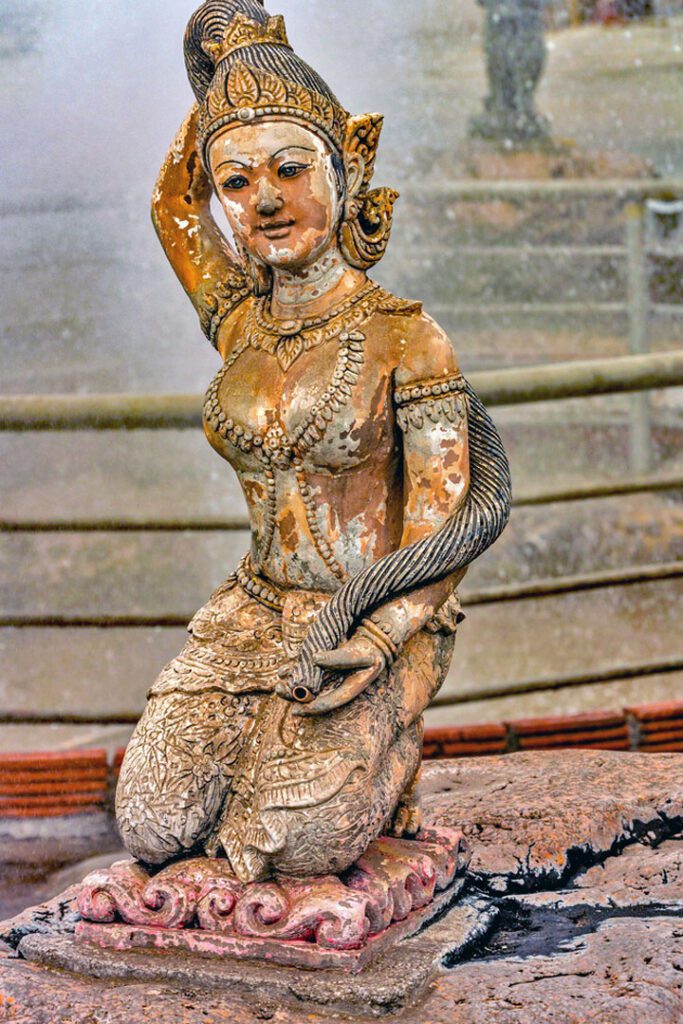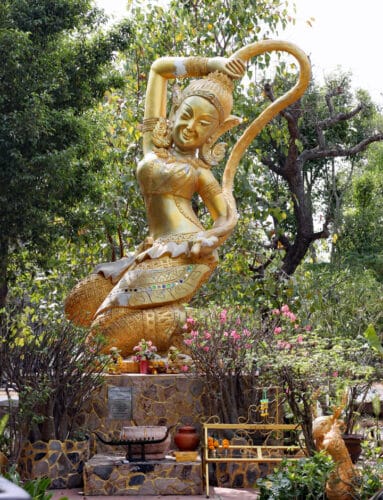Phra Mae Thoranee: the revered Earth Goddess

Phra Mae Thoranee
Phra Mae Thoranee or Nang Thoranee, the earth goddess of Theravada Buddhist mythology. She is worshiped and revered in Myanmar, Thailand, Cambodia, Laos and Sipsong Panna in Yunnan. In Thailand, she is a source of worship, especially in Isan, in the Northeast of Thailand.
The cult surrounding her is a fine example of the complexity of Southeast Asian religious and superstitious beliefs, which draw on multiple religious/philosophical traditions, including local beliefs that predate the introduction of Buddhism to the wider region.
To this day it is not really clear how she has acquired a place in the Buddhist universe. After all, her name does not appear anywhere in the Pali Canon, the collection of ancient texts that form the basis of Theravada Buddhism. Precisely because she is absent from the Pali Canon, some Buddhist scholars and academics have concluded that Phra Mae Thoranee was created from pre-Buddhist local legends and lore. That she was born of a colorful amalgam of local beliefs mixed with Brahmanical legends about the earth and the stories of the Buddha's life. A theory with a lot of merit, but strangely enough it is not part of the indigenous pantheons of Southeast Asia with the qnak of Cambodia, the phi of Thailand or the nats of Burma.
In all probability, the legend of Phra Mae Thoranee was one of the countless stories that arose shortly after the death of the Buddha and that reached the region in the early centuries of our era, via India and perhaps Sri Lanka, and about the first millennium, together with the Bhumisparsamudra – Enlightenment stories and ritual texts – were part of Buddhist mythology. The first images we know of her in Thailand are in any case quite old because they date from the fourteenth century.
The story of Phra Mae Thoranee goes roughly as follows: During a long meditation session at the end of which the Buddha attained enlightenment, he was said to have faced many trials and challenges. One such challenge came from the vengeful demon Mara who tried to attack the Buddha with his army. In response to this aggression, the Buddha touched the ground and called the earth to be his witness against Mara. A prayer to which the earth goddess – Phra Mae Thoranee – promptly appeared in the form of an attractive woman. Phra Mae Thoranee squeezed the water from her soaking hair, causing a flood that drowned Mara's armies and allowed the Buddha to continue his quest for Enlightenment undisturbed.
Shrines for the earth goddess can be found in all of Thailand and especially in Isaan. Many Thai people come to these shrines to pray, pay homage or ask for help by making offerings to Phra Mae Thoranee. After all, she is seen as an embodiment of compassion. In many shrines and temples, water ceremonies also take place at her image. This may have everything to do with water playing a leading role in her legend. During the Thai Buddhist Water Ceremony, monks pour water from a glass into a vase and then onto the ground to return the water to the earth deity. The belief here is that pouring the water is a way of connecting the elements in Buddhist cosmology.

Mae Thoranee
Many of the rituals addressed to the Earth Goddess are focused on driving away evil spirits and misfortune. I myself once experienced, near our home, during Songkran – the Thai New Year – in a remote corner of the Isan province of Buriram, a ritual dedicated to the goddess in which an improvised bamboo altar was built at the intersection of two roads. On these were offered offerings of betel leaves, areca nuts, molasses, rice, bananas, incense, etc. in banana wood bowls arranged on the arms of the altar. There was an offering bowl for each of the gods: the offering of the earth goddess was placed on placed on the ground, Indras on the top of the altar and the offerings to the tutelary gods of our fishing hamlet at the Mun were arranged on the four extremities as well as on the central arms of the altar The earthly deity was awakened by an invocator and solemnly asked for the demons and drive the misfortune out of the village with an ancient ritual formula.
In Isaan, many firmly believe that the earth goddess sleeps deep underground and, like the legendary Naga serpent, rotates daily. The diagrams used to invoke her show that on Sunday her head points east, Monday southeast, Tuesday south, Wednesday southwest, Thursday west, Friday northwest, and Saturday northeast . When one wants to summon her, one gives to an initiate a stick of bananas the length of one hand, four balls of cooked rice, sugar cane, betel nut, cigarettes and pickled tea leaves to offer them to the goddess. The provider of these offerings digs a hole in the earth with a maximum depth of one hand's length towards her head (not her feet). One then places eight small candles and four yellow flowers in this hole and awakens the goddess by loudly calling out her name and stamping the ground three times, while a secret formula is spoken.
However, Phra Mae Thoranee's influence extends beyond the temples. Because earth and water flow together in the cult around her, her image is used in the logo of the urban water company of Bangkok. A similar logo can also be found on the insignia of the staff of the Phnom Penh water company and on the gates of the Cambodian Ministry of Hydrology.
A similar logo was also used by the Thai Democratic Party or “Pak Prachatipat” for the party's official seal when it was christened in Bangkok on April 6, 1946. When the founders of this center-right party, including Khuang Aphaiwong and the brothers Seni and Kukrit Pramoj, gathered in Pramoj's law office on Rajadamnoeurn Street to draft the party's bylaws, they overlooked the very beautiful Mae Thoranee fountain on Sanam Luang. And apparently that must have inspired them…. Si non e vero….


Another wonderful story, Lung Jan, with more interesting details than I did at the time, already 5 years ago. wrote:
https://www.thailandblog.nl/achtergrond/mae-thorani-aardgodin/
A few notes. The stories in all religions should seldom be taken literally, but are mainly symbolic of moral views.
Phra Mae Thorani symbolizes the Buddhist concept of merit. The cleansing water that Mae Thorani wrings from her hair refers to the many merits of the Buddha that benefit the whole world. Pouring water into bowls during Buddhist rituals also says, "Let my merit be for the benefit of others."
It is also an admonition to generosity, a virtue called 'dana' in Buddhism, related to the word 'donation'.
I often look for comparisons with other cultures and religions. Christianity knows baptism where while pouring some water over a head and the formula 'I baptize you in the name of the Father, the Son and the Holy Spirit' someone is delivered from original sin descending from Adam and Eve, after which you then commit your own sins.
Nice interesting story!
Very interesting story.
Only I can't put Mother Earth Phra Mae Prithawi next to Phra Mae Thoranee.
Both are earth goddesses in Thai.
Can someone help me out of confusion here?
That's the same goddess with a different name, Chander. Also the Buddha has many names in literature, in different countries.
Earth's many names
Even in Buddhism, Mother Earth's many names are diverse. She is celebrated in a big way all over Southeast Asia as Phra Mae Thorani. In Pali, she is Vasudhara — whose name means “stream of gems” — an important deity in Nepal today. In India she was known as Prithvi (Prthvi, Prithawi)), Ksiti, Bhumi, Dharani. In Burma, Wathondare. Her statues appear in many temples, often celebrated with water ceremonies, commemorating the “wringing of her hair” and the torrent of Buddha's merits that swept away Mara. In Burma, they celebrate this by pouring water from a glass, drop by drop, to a vase, confessing faith with the hsu taung imaya dhammanu, as they proceed. She is equally associated with Yellow or Golden Tara.
https://buddhaweekly.com/mother-earth-witness-of-lord-buddhas-merits-vasudhara-phra-mae-thorani-prithvi-bhumi-the-witness-of-all-our-merits/
In Thai, the name is พระแม่ธรณี, phrá mâe tho-rá-nie. Phra is, of course, the title for monks, priests, buddhas, gods and other revered persons of prestige. And mâe tho-rá-nie (mother + earth / soil) is mother earth. Note: "mother" is (also) a title that indicates honor and respect.
นางธรณี, naang tho-rá-nie, can also. Naang is a word to address women: Madam/lady Thoranie.